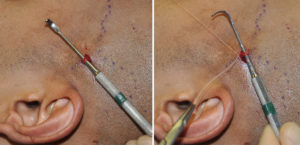While everyone knows what a migraine headache is, determining its exact cause in many patients is not so obvious. Recent advances in migraine care have been to determine if there is a specific extracranial cause that triggers the migraine. The focus has been on nerve compression of certain sensory nerves where they exit from the skull. These trigger sites include the frontal, occipital, temporal and nasal areas.
The temporal migraine trigger site is the most perplexing due to a close association of vessels (anterior temporal branch), nerves (auriculotemporal and zygomaticotemporal) and the temporalis muscle and enveloping fascia. Many patients point to the temporal area as the origin of their migraines and often can pin point one very specific area.
In the October 2015 issue of the journal Plastic and Reconstructive Surgery, an article was published entitled ‘The Current Means for Detection of Migraine Headache Trigger Sites’. In this paper the most interesting aspect of it was the section devoted to Doppler Signals. Since some of the sensory nerves can intersect or become intertwined with an artery, the migraine headache may be described as a throbbing type headache. This seems to be particularly true in the temporal area in my experience. Physical examination may demonstrate a pulsatile vessel and a hand held doppler unit can be useful to pick up the arterial signal at the site of the pain. This cause of some temporal headaches may be due to the anterior branch of the superficial temporal artery intersecting with the auriculotemporal nerve. But the doppler is also useful for isolating pulsatile flow in temporal areas that may not be considered traditional migraine trigger sites.

Spot ligation of small temporal arterial branches is a part of temporal migraine surgery and can be an effective strategy for reducing certain types of pulsatile migraine headaches in temporal region.
Dr. Barry Eppley
Indianapolis, Indiana


